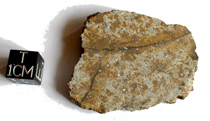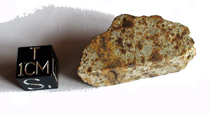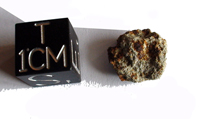L Group
With about 6,500 members (including probable pairings), the chondrites of the L group represent the second largest group of ordinary chondrites. The "L" stands for "low iron" - especially in its free form. L chondrites contain a weight percentage of 20 to 25% total iron, but only 4 to 10% nickel-iron is found as free metal. Therefore, L chondrites are also attracted to a magnet, but much less than their cousins of the H group.
The L chondrites belong to the petrological types 3 - 7, with a characteristic peak at type 6. More than 4,000 have been classified as L6, about 1,300 as L5, just 400 as L4, and only about 300 as L3. Brecciated members that show clasts of several petrologic types do occur, but they are more rare than in the H group. Besides magnetite and nickel-iron, the L chondrites are composed of olivine and the orthopyroxene hypersthene. Consequently, they have been called "olivine hypersthene chondrites" or "hypersthene chondrites" in older literature and papers. However, this name is not fitting modern meteoritics and the Meteoritical Society discourages the use of these names.
When it comes to the origin of the L chondrites it has been suspected
that they might be former parts of the near-Earth asteroid 433 Eros which
has been intensely studied by the spacecraft NEAR-Shoemaker recently. The
reflectance spectra of 433 Eros and the L chondrites seem to match closely
- however, most L chondrites show signs of severe shock metamorphism
suggesting a violent history of its parent body. Maybe the real parent of
the L chondrites was some kind of relative or a former part of 433 Eros
that has been entirely disrupted when it collided with another asteroid.
Allan
Hills A76009
Abbreviation: ALH 76009, L6
Found: January 20 1977
Country: Antarctica [Collected jointly by ANSMET (US) and NIPR (Japan)]
TKW 407 kg
West of Allan Nunatak on the edge of the Polar plateau, Victoria
Land, Antarctica.
76°42'26"S.,
159°07'43"E.
Class
and type: Stone. Olivine-hypersthene chondrite (L6). Olivine Fa24.1.
Number of individual specimens: 33
These
specimens are from the R. Bartoschewitz collection
|
 
|
|
|
|
ALH 76009 00
16.77 gr
Very nice complete slice of this rare meteorite from
Antartica, showing shock veins !
SOLD |
|
|
|
|
|
|
|
ALH 76009 01
17.80 gr
Nice endcut showing shock veins
SOLD
|
|
|
|
  |
|
|
|
|
|
|
 
|
|
|
|
ALH 76009 02
13.90 gr
Endcut with shining metal and shock veins
SOLD
|
|
|
|
|
|
|
|
ALH 76009 03
0.85 gr
Nice fragment for this meteorite coming from
Antartica
SOLD
|
|
|
|
  |
|
|
|
|
|
|
|